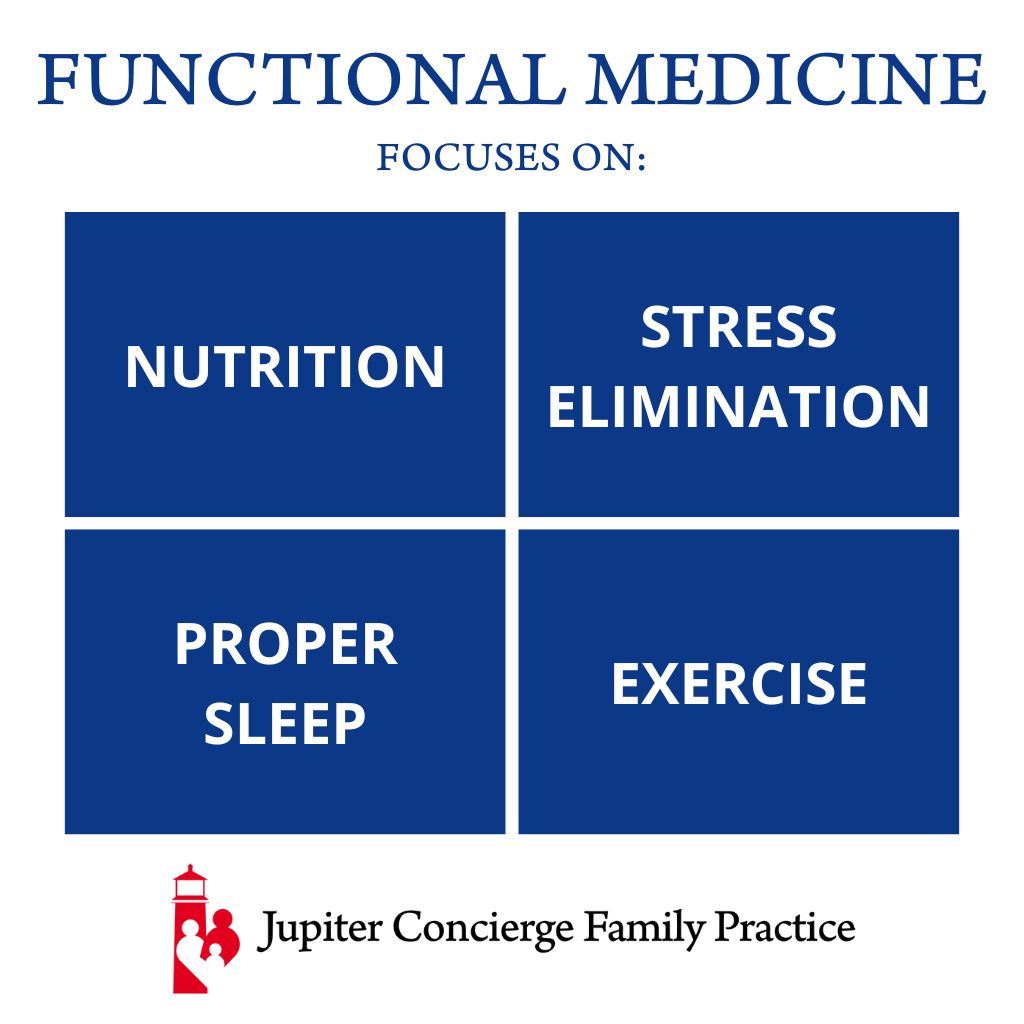
Like all board-certified physicians in the U.S., I’m trained in conventional medicine.
Conventional medicine provides treatment to stop bad things that are already happening. We’re treating something that’s already in motion, trying to arrest it or change its direction. This is a reasonable and necessary approach.
I became interested in functional medicine because conventional medicine alone generally suffers from three significant gaps:
- It doesn’t usually prevent an illness from recurring.
- It doesn’t repair the damage caused by illness.
- It doesn’t usually prevent illness to begin with.
Functional medicine fills these gaps by providing lifestyle and therapeutic recommendations to promote patient well-being, helping improve the body’s resilience and healing, and interrupting dysfunctional processes before they progress into full-blown disease.
In particular, functional medicine focuses on proper sleep, exercise, nutrition, and stress elimination to help patients live a healthy and vibrant life.
I believe both functional and conventional medical care are necessary, and both provide benefits to patients and physicians alike. Here, I want to share how functional medicine can augment conventional care, how to become both a conventional and functional medicine doctor, and some easy ways conventional physicians can weave functional medicine principles into their practices.
The Benefits of Functional Medicine for Patients
One of the beauties of functional medicine is that it offers the opportunity for interdependence to the patient. When a patient can become an active participant in their own healthcare, the nature of the game changes.
We all know it’s less than ideal for a patient’s view of healthcare to be limited to this: only visit a physician when you become sick, and the doctor will give you something to make it better.
This perspective seemingly absolves patients from making lifestyle decisions that result in the healthiest life possible. When patients don’t have agency in their health, problems take longer to diagnose, illnesses take longer to treat, and recurrences are more likely. Everything becomes more costly and less effective.
Functional medicine averts or minimizes these issues as much as possible by actively engaging patients in their own healthcare and providing them with the tools and knowledge to cooperate with their doctor in achieving and maintaining health.
The Benefits of Functional Medicine for Doctors
Whether we’re primary care physicians or specialists, we want our patients to get better. It’s frustrating for us when patients come back with the same complaint over and over; we want resolution, too.
Functional medicine helps facilitate that better resolution.
This is the other side of the coin from patient benefits. In functional medicine, the physician and the patient become partners. The physician no longer occupies the role of sole caretaker of patient health; the patient actively bears part of the burden, as well.
As a result, patient compliance increases. They better understand the purpose and utility of medical advice, and they follow it.
Say, for example, you’re going to do an angioplasty to open up an artery in the heart. Conventionally, the patient receives medication to prevent a clot from recurring. But what if the patient also takes measures to decrease the inflammation that started that disease process in the first place? The patient becomes a partner in the process, making treatment more effective.
Often, the more a patient takes on from a functional approach, the fewer the treatments necessary for their case. Risks fall, outcomes improve, and quality of life increases.
How Can Doctors Incorporate Functional Medicine Into Conventional Practice?
To fully practice functional medicine requires time. You need more time with patients because functional medicine involves deep inquiry and a communicative partnership. For most physicians, however, time is a major constraint.
In light of that restriction, then, below are three suggestions to help you incorporate functional medicine principles into your practice in a time-efficient manner.
Focus on the top 20%. For most of us, the top 20% of issues we treat are responsible for 80% of the patients who come in. If you start by concentrating on these issues, you can create a pre-built library of functional medicine recommendations for 80% of your patients.
Consider creating ancillary resources with lifestyle recommendations for some of the most common complaints, like hypertension, high cholesterol, GERD, diabetes, back pain, upper respiratory infections, fatigue, abdominal pain, heartburn, memory loss — anything you see often for which you can create simple recommendations. Such advice can improve patient outcomes while making efficient use of physicians’ time.
Talk pharma. Another effective principle you can incorporate even within tight time constraints is prioritizing conversations with patients about their pharmaceutical medications.
It’s important for patients to understand the intent behind a medication. What do we want this medication to accomplish? What can’t it accomplish? What are the risks and benefits?
Patients should also understand what actions they can take to increase the effectiveness of the treatment, and anything they can do to minimize the possibility of side effects.
Providing patients with a thorough and empowered understanding of their prescriptions will benefit their health more than the medication alone. These kinds of conversations help improve compliance and minimize side effects.
Explore functional medicine resources. The Institute for Functional Medicine (IFM) is an excellent resource not only for anyone looking to become a certified functional medicine doctor but also for physicians simply interested in learning more about functional medicine.
IFM offers helpful, clear definitions — “Functional medicine determines how and why illness occurs and restores health by addressing the root causes of disease for each individual” — articles on topics like sleep hygiene, book recommendations, podcasts, videos, and even recipes. Over time, you can explore the bounty of information IFM has made available and incorporate ideas and resources that would benefit your patients and your practice.
Final Thoughts
While I would certainly encourage anyone wanting to know how to become a functional medicine doctor to pursue in-depth study and certification, I also recognize this isn’t the path for every physician.
For physicians not pursuing certification, or not right away, I hope the principles in this article will help you and your patients enjoy some of the benefits of functional medicine and its complementary nature to conventional medicine.

Dr. David Rosenberg
Dr. Rosenberg is a board-certified Family Physician who obtained a BS in Chemistry at Georgia's Mercer University in 1983 and a medical degree from the University of Miami in 1988. He completed his residency in Family Medicine at The Washington Hospital in Washington, Pennsylvania, in 1991 and then practiced Emergency Medicine at Palm Beach Gardens Medical Center for two years. In 1993 he started private practice in Jupiter.
Dr. Rosenberg has been married to his wife Mary for 38 years and they have three grown children together. Some of his interests include being a huge baseball fan, sailing, snow skiing, self-development, and learning to play piano.

